Carol Baldwin's Blog, page 54
June 15, 2015
SCBWI Florida Workshop Part II- Querying in the Digital Age
This is my second blog post from the young adult workshop I recently attended. Erica Rand Silverman is an agent with Sterling Lord Literistic and Jacquelyn Mitchard is a prolific author as well as an editor-in-chief at Merit Press. Click here for Part I.
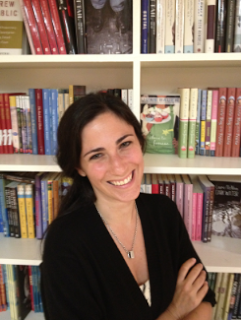 Erica Rand SilvermanThese notes are from Erica's powerpoint presentation.
Erica Rand SilvermanThese notes are from Erica's powerpoint presentation.
* Research agents in advance. Find out who represents what genre.
* Don’t ever pay for query services. Using Query Tracker is acceptable.
* Prepare your query letter carefully. Agents will respond with the same amount of care which you take. "Sometimes we hear pings within our office and know everyone is getting the same query at the same time." That's ridiculous with an office full of agents looking for everything from children's picture books to adult non-fiction. It is appropriate to reference the agent's client list and mention what you like about these books. By doing this you are showing why you are seeking representation from this agent.
* Don’t name drop in your query.
* There was a phase when publishers bought self-published books because they had great sales on Amazon. This is no longer happening.
* Don’t be overly personal. Be yourself! Your work has to be first and foremost.
* It's all about timing: the right moment with the right person.
* Don’t list ten different projects you have.
* Mention your work first, then your credentials.
* If you find someone you really want to work with don’t submit to another agent. If you do multiple submits, be transparent at the bottom of the email.
* Follow the agency's guidelines for email vs. snail mail. Email may get seen quickly, but may never be seen again. Paper will eventually get read.
* If an agent responds with “I’m interested,” feel free to nudge if you haven't heard back in a month. If they don’t respond to your initial query, don’t nudge.
* A big problem in publishing is not having enough time to think. Writers need to be patient!
* If you receive more than one offer, do a happy dance and then select wisely. You need to give agents time to respond- at least one or two weeks. It is appropriate to write, “I’d love to hear from you if you’re interested before I make a decision on how to move forward.” Treat other professionals with respect. If an agent is workshopping your work, they’re interested. It's like dating. Don't query another agent if the first agent is subbing your work.
* Erica recommended reading this blog from Wolff Literary on choosing the right agent.
**************************************Here are some of my previous posts on agents:
A Day in the Life of an Agent
Insights into Editing: A Conversation with Carin Siegfried
If You Give a Writer a Cookie
And on querying:
Putting Your Best Query Forward
Chasing Your Dream
Quintessential Queries (including Josh and Tracey Adams' tips, "Do's and Don't of Queries")

 Erica Rand SilvermanThese notes are from Erica's powerpoint presentation.
Erica Rand SilvermanThese notes are from Erica's powerpoint presentation.* Research agents in advance. Find out who represents what genre.
* Don’t ever pay for query services. Using Query Tracker is acceptable.
* Prepare your query letter carefully. Agents will respond with the same amount of care which you take. "Sometimes we hear pings within our office and know everyone is getting the same query at the same time." That's ridiculous with an office full of agents looking for everything from children's picture books to adult non-fiction. It is appropriate to reference the agent's client list and mention what you like about these books. By doing this you are showing why you are seeking representation from this agent.
* Don’t name drop in your query.
* There was a phase when publishers bought self-published books because they had great sales on Amazon. This is no longer happening.
* Don’t be overly personal. Be yourself! Your work has to be first and foremost.
* It's all about timing: the right moment with the right person.
* Don’t list ten different projects you have.
* Mention your work first, then your credentials.
* If you find someone you really want to work with don’t submit to another agent. If you do multiple submits, be transparent at the bottom of the email.
* Follow the agency's guidelines for email vs. snail mail. Email may get seen quickly, but may never be seen again. Paper will eventually get read.
* If an agent responds with “I’m interested,” feel free to nudge if you haven't heard back in a month. If they don’t respond to your initial query, don’t nudge.
* A big problem in publishing is not having enough time to think. Writers need to be patient!
* If you receive more than one offer, do a happy dance and then select wisely. You need to give agents time to respond- at least one or two weeks. It is appropriate to write, “I’d love to hear from you if you’re interested before I make a decision on how to move forward.” Treat other professionals with respect. If an agent is workshopping your work, they’re interested. It's like dating. Don't query another agent if the first agent is subbing your work.
* Erica recommended reading this blog from Wolff Literary on choosing the right agent.
**************************************Here are some of my previous posts on agents:
A Day in the Life of an Agent
Insights into Editing: A Conversation with Carin Siegfried
If You Give a Writer a Cookie
And on querying:
Putting Your Best Query Forward
Chasing Your Dream
Quintessential Queries (including Josh and Tracey Adams' tips, "Do's and Don't of Queries")

Published on June 15, 2015 03:00
June 8, 2015
SCBWI Florida Workshop Part I- Why Write Young Adult?
Congratulations to Vijaya Bodach who won Rory's Promise on last week's blog.
*******
Last Saturday I attended the Florida SCBWI's mid-year workshop. I spent the entire day soaking up information from two talented women, Erica Rand Silverman and Jacquelyn Mitchard. Since they generously agreed to share the content of their workshop, my blog posts over the next few weeks will be from my notes. I will be listing the main speaker for each topic, but my notes include contributions from both women.
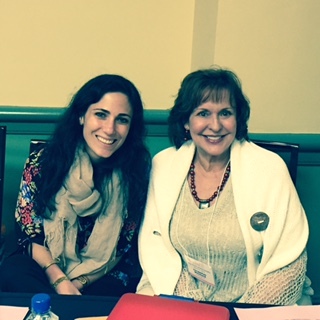 Erica and Jacquelyn
Erica and Jacquelyn
Why Write Young Adult?Jacquelyn MitchardProtagonist and (usually) the antagonist are teenagers. They do the heavy lifting; they're the ones who get in and out of trouble.They're usually 16 or 17. Rules about writing are there. You can break them if you do it with authenticity and class.Young Adult literature is relatively new. Catcher in the Rye (1950) was first YA book. Voice--the way in which things are said--is so important. "Young adult literature often expresses the alienation that even happy teenagers feel."Young adult is the only segment of publishing that has been growing for 20 years.The topography of teenagers' emotions is huge. "In high school they are changing on a molecular level into another person."In the 20th century, psychologists realized that an adolescent had to separate from family to become his/her own person. This was reflected in literature such as The Chocolate War and The Outsiders.Young adult is often written in an intimate, conversational style. Reader can connect with the characters on a friendship level. Adolescents still have enough of the child inside of them that they believe characters are real. (Reason why they'll get dressed up as a character for a book signing.)New Adult is already over.As an editor at Merit Press, Jacquelyn is looking for realistic contemporary fiction. "Hormones and heat, but not foul or graphic."Write large, not subtle. Don’t attempt young adult if you don’t read it and enjoy it.Unusual set-ups are good. Fresh. Not contemporary slang that will give the book a shelf life of two years.In young adult fiction, layers are pealed back. Emotions are up front and genuine. The teen's survival (either physical or emotional) is at stake.One half of young adult readers are adults because dark and light are more extreme.Young adult brings rebels to life. Readers can live vicariously through characters. Love and respect your teen audience. "When you do this kind of writing you can change the world without preaching."When she is in the middle of writing a book, before she goes to sleep Jacquelyn thinks, “I’m going to be X now.” This taps into her sub-conscious.A book can’t be about an issue, like a parent's alcoholism. It’s about the conflict that is raised within the protagonist as a result of the parent's alcoholism. If you want to write young adult, you better be reading it.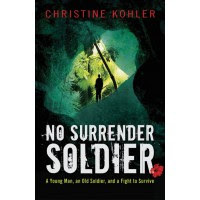 This is one of the books from Merit Press.
This is one of the books from Merit Press.
Written by my FB friend, Christine Kohler,
it's on my TBR list!

*******
Last Saturday I attended the Florida SCBWI's mid-year workshop. I spent the entire day soaking up information from two talented women, Erica Rand Silverman and Jacquelyn Mitchard. Since they generously agreed to share the content of their workshop, my blog posts over the next few weeks will be from my notes. I will be listing the main speaker for each topic, but my notes include contributions from both women.
 Erica and Jacquelyn
Erica and JacquelynWhy Write Young Adult?Jacquelyn MitchardProtagonist and (usually) the antagonist are teenagers. They do the heavy lifting; they're the ones who get in and out of trouble.They're usually 16 or 17. Rules about writing are there. You can break them if you do it with authenticity and class.Young Adult literature is relatively new. Catcher in the Rye (1950) was first YA book. Voice--the way in which things are said--is so important. "Young adult literature often expresses the alienation that even happy teenagers feel."Young adult is the only segment of publishing that has been growing for 20 years.The topography of teenagers' emotions is huge. "In high school they are changing on a molecular level into another person."In the 20th century, psychologists realized that an adolescent had to separate from family to become his/her own person. This was reflected in literature such as The Chocolate War and The Outsiders.Young adult is often written in an intimate, conversational style. Reader can connect with the characters on a friendship level. Adolescents still have enough of the child inside of them that they believe characters are real. (Reason why they'll get dressed up as a character for a book signing.)New Adult is already over.As an editor at Merit Press, Jacquelyn is looking for realistic contemporary fiction. "Hormones and heat, but not foul or graphic."Write large, not subtle. Don’t attempt young adult if you don’t read it and enjoy it.Unusual set-ups are good. Fresh. Not contemporary slang that will give the book a shelf life of two years.In young adult fiction, layers are pealed back. Emotions are up front and genuine. The teen's survival (either physical or emotional) is at stake.One half of young adult readers are adults because dark and light are more extreme.Young adult brings rebels to life. Readers can live vicariously through characters. Love and respect your teen audience. "When you do this kind of writing you can change the world without preaching."When she is in the middle of writing a book, before she goes to sleep Jacquelyn thinks, “I’m going to be X now.” This taps into her sub-conscious.A book can’t be about an issue, like a parent's alcoholism. It’s about the conflict that is raised within the protagonist as a result of the parent's alcoholism. If you want to write young adult, you better be reading it.
 This is one of the books from Merit Press.
This is one of the books from Merit Press.Written by my FB friend, Christine Kohler,
it's on my TBR list!

Published on June 08, 2015 06:35
June 1, 2015
Rory's Promise: A Review and a Giveaway
Rory is a 12-year-old street smart orphan who keeps her promises.
First, she is determined to keep her promise to her dying mother that she’ll take care of her younger sister, Violet.
Second, she will absolutely not break her promise to five-year-old Violet: Nothing will ever, ever separate them.
It’s just that keeping these promises proves to be a lot more difficult than even spunky, Irish Rory Fitzpatrick ever imagined.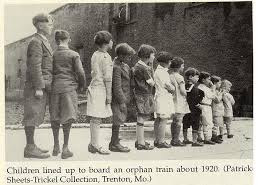 From http://christinabakerkline.com/blog/m..., Michaela MacColl and Rosemary Nichols use the facts of the Orphan Trains in this fictionalized account starring Rory as the sharp-witted, courageous heroine. Between 1853 and 1929 250,000 orphaned, abandoned, or homeless children were put on trains and brought out west. The Children’s Aid Society of New York sponsored many of them. At times, the families used the children for underage labor; this was before there were child labor and foster care laws. On the other hand, The Foundling, a Catholic organization, took great care to place the orphans in their care in “good, Catholic families.”
From http://christinabakerkline.com/blog/m..., Michaela MacColl and Rosemary Nichols use the facts of the Orphan Trains in this fictionalized account starring Rory as the sharp-witted, courageous heroine. Between 1853 and 1929 250,000 orphaned, abandoned, or homeless children were put on trains and brought out west. The Children’s Aid Society of New York sponsored many of them. At times, the families used the children for underage labor; this was before there were child labor and foster care laws. On the other hand, The Foundling, a Catholic organization, took great care to place the orphans in their care in “good, Catholic families.”
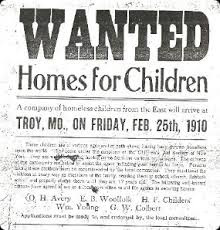 http://www.chsfs.org/blog/evolution-o... Rory herself is a fictional character, many of the other characters in the book are real: Sister Anna, the nun in charge of placing the children; George Swayne, the agent who worked with The Foundling; Father Constant Mandlin a young French priest who couldn't communicate well with his parishioners as well as the white women who were furious when Mexican working-class families received children and they didn’t.
http://www.chsfs.org/blog/evolution-o... Rory herself is a fictional character, many of the other characters in the book are real: Sister Anna, the nun in charge of placing the children; George Swayne, the agent who worked with The Foundling; Father Constant Mandlin a young French priest who couldn't communicate well with his parishioners as well as the white women who were furious when Mexican working-class families received children and they didn’t.
 http://www.neh.gov/humanities/2007/no... I am getting ahead of the story.
http://www.neh.gov/humanities/2007/no... I am getting ahead of the story.
Rory’s goal to make sure she and Violet stay together drives this story forward. As far as she’s concerned, not even plans to take Vi out west to the Arizona territory will stop her. Although she successfully sneaks on board the orphan’s train, her journey is not without moments of doubt. Families who couldn’t have children of their own wanted cute little 5-year-olds—but would anyone want her sister also?
After a stressful journey, when the train finally arrives in Clifton, Arizona Territoryeveryone is shocked. First, the stench of sulfur and a building belching dark smoke greet them. Rory soon learns that the town revolves around mining copper. In the small station, a mob of loud, white women pound on the train’s windows. Later Rory is told,
The white women are demanding and ugly. Rory is actually relieved when Violet and a little boy, William, are assigned to two kind Mexicans, Elena and Ramon Martinez. But her relief that Violet has found a family is tempered by her anguish of wanting to stay with her sister. Can she find a way to convince the Martinez family to adopt her also?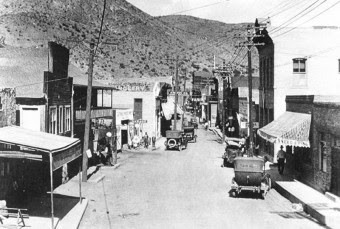 Downtown Clifton, circa 1915
Downtown Clifton, circa 1915
http://visitcliftonaz.com/rich-histor... concept of family--people who look alike--is challenged and her courage and loyalty are severely tested. She needs every ounce of her abilities to think quickly and to act fast to help the orphans and to keep her promises.
At the risk of including a spoiler, I must share one of my favorite parts of this book. At the end, when she tells Violet about the Martinez’s plan to take them both to Mexico Rory says,
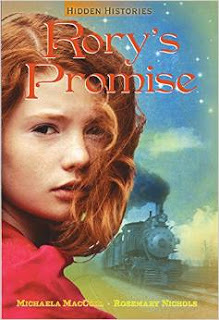
Thanks to the generosity of Boyds Mills Press, I’m giving away a copy of this middle-grade novel for girls. It documents a little-known period in American history, when Mexican families fought for the right to adopt white children. Also useful as a classroom book, Rory’s Promise will spark some interesting discussions about diversity. If you are interested in adding this book to your library or donating it to a classroom, please leave a comment by Thursday, June 4. If you are new to my blog, please leave your email address also.

First, she is determined to keep her promise to her dying mother that she’ll take care of her younger sister, Violet.
Second, she will absolutely not break her promise to five-year-old Violet: Nothing will ever, ever separate them.
It’s just that keeping these promises proves to be a lot more difficult than even spunky, Irish Rory Fitzpatrick ever imagined.
 From http://christinabakerkline.com/blog/m..., Michaela MacColl and Rosemary Nichols use the facts of the Orphan Trains in this fictionalized account starring Rory as the sharp-witted, courageous heroine. Between 1853 and 1929 250,000 orphaned, abandoned, or homeless children were put on trains and brought out west. The Children’s Aid Society of New York sponsored many of them. At times, the families used the children for underage labor; this was before there were child labor and foster care laws. On the other hand, The Foundling, a Catholic organization, took great care to place the orphans in their care in “good, Catholic families.”
From http://christinabakerkline.com/blog/m..., Michaela MacColl and Rosemary Nichols use the facts of the Orphan Trains in this fictionalized account starring Rory as the sharp-witted, courageous heroine. Between 1853 and 1929 250,000 orphaned, abandoned, or homeless children were put on trains and brought out west. The Children’s Aid Society of New York sponsored many of them. At times, the families used the children for underage labor; this was before there were child labor and foster care laws. On the other hand, The Foundling, a Catholic organization, took great care to place the orphans in their care in “good, Catholic families.”
 http://www.chsfs.org/blog/evolution-o... Rory herself is a fictional character, many of the other characters in the book are real: Sister Anna, the nun in charge of placing the children; George Swayne, the agent who worked with The Foundling; Father Constant Mandlin a young French priest who couldn't communicate well with his parishioners as well as the white women who were furious when Mexican working-class families received children and they didn’t.
http://www.chsfs.org/blog/evolution-o... Rory herself is a fictional character, many of the other characters in the book are real: Sister Anna, the nun in charge of placing the children; George Swayne, the agent who worked with The Foundling; Father Constant Mandlin a young French priest who couldn't communicate well with his parishioners as well as the white women who were furious when Mexican working-class families received children and they didn’t.
 http://www.neh.gov/humanities/2007/no... I am getting ahead of the story.
http://www.neh.gov/humanities/2007/no... I am getting ahead of the story.Rory’s goal to make sure she and Violet stay together drives this story forward. As far as she’s concerned, not even plans to take Vi out west to the Arizona territory will stop her. Although she successfully sneaks on board the orphan’s train, her journey is not without moments of doubt. Families who couldn’t have children of their own wanted cute little 5-year-olds—but would anyone want her sister also?
But the more happy families she saw, the more she wondered if Vi had a future that might not include Rory. If Vi had a chance for parents and a home, could Rory stand in the way of that? p. 144
After a stressful journey, when the train finally arrives in Clifton, Arizona Territoryeveryone is shocked. First, the stench of sulfur and a building belching dark smoke greet them. Rory soon learns that the town revolves around mining copper. In the small station, a mob of loud, white women pound on the train’s windows. Later Rory is told,
"This place is bad for making babies. The air is thick with fumes and the water is full of metals from the mines. Nothing grows here. No trees. No babies.” (pp.171-2)A new conflict—one based on history—enfolds. The Protestant women believe they have a right to the children since they are the same race and skin color. But the children have been promised to the Mexicans so they can be raised in “good, Catholic homes.”
The white women are demanding and ugly. Rory is actually relieved when Violet and a little boy, William, are assigned to two kind Mexicans, Elena and Ramon Martinez. But her relief that Violet has found a family is tempered by her anguish of wanting to stay with her sister. Can she find a way to convince the Martinez family to adopt her also?
 Downtown Clifton, circa 1915
Downtown Clifton, circa 1915http://visitcliftonaz.com/rich-histor... concept of family--people who look alike--is challenged and her courage and loyalty are severely tested. She needs every ounce of her abilities to think quickly and to act fast to help the orphans and to keep her promises.
At the risk of including a spoiler, I must share one of my favorite parts of this book. At the end, when she tells Violet about the Martinez’s plan to take them both to Mexico Rory says,
"We’ll never see the Foundling again—or Sister Anna or the other kids,” she warned. “We’ll have to learn a new language too, Vi. And there won’t be any American kids to play with. We’ll always be different."
“Special?” Vi asked, her blue eyes shining with pleasure.
“”I guess so,” Rory said ruefully. (p. 250)Leave it to a five-year-old to have a different perspective on what their new life will be!

Thanks to the generosity of Boyds Mills Press, I’m giving away a copy of this middle-grade novel for girls. It documents a little-known period in American history, when Mexican families fought for the right to adopt white children. Also useful as a classroom book, Rory’s Promise will spark some interesting discussions about diversity. If you are interested in adding this book to your library or donating it to a classroom, please leave a comment by Thursday, June 4. If you are new to my blog, please leave your email address also.

Published on June 01, 2015 03:00
May 25, 2015
Primary Lessons: A Memoir by Sarah Bracey White
“As an African-American child growing up in the segregated pre-Civil Rights South, Sarah Bracey White pushed against the social conventions that warned her not to rock the boat, even before she was old enough to fully understand her urge to defy the status quo. In her candid and poignant memoir, Primary Lessons, White recalls a childhood marked by equal measures of poverty and pride—formative years spent sorting through the “lessons” learned from a complicated relationship with her beloved, careworn mother and from a father’s absence engendered by racial injustice and compromised manhood.” (Press release from CavanKerry Press)
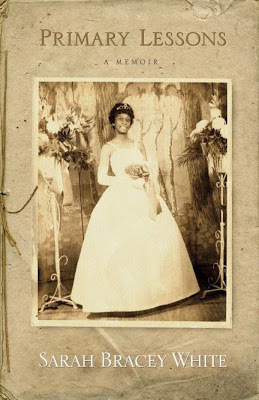 Photo taken in 1963 at Sarah's Debutante Cotillion, age 17I don’t normally quote a press release when introducing a book, but I couldn’t improve on this synopsis of Sarah Bracey White’s memoir. I first “met” Sarah in the pages of Childrenof the Dream: Our Own Stories of Growing Up Black in America. After reading about her experiences as a Sumter, South Carolina teen working in a camp for wealthy New England girls, I friended her on Facebook and told her about my work-in-progress. She promptly sent me a copy of her memoir which, has since helped fuel writing
Half-Truths
. I think Sarah's memoir is best revealed in her own words.
Photo taken in 1963 at Sarah's Debutante Cotillion, age 17I don’t normally quote a press release when introducing a book, but I couldn’t improve on this synopsis of Sarah Bracey White’s memoir. I first “met” Sarah in the pages of Childrenof the Dream: Our Own Stories of Growing Up Black in America. After reading about her experiences as a Sumter, South Carolina teen working in a camp for wealthy New England girls, I friended her on Facebook and told her about my work-in-progress. She promptly sent me a copy of her memoir which, has since helped fuel writing
Half-Truths
. I think Sarah's memoir is best revealed in her own words.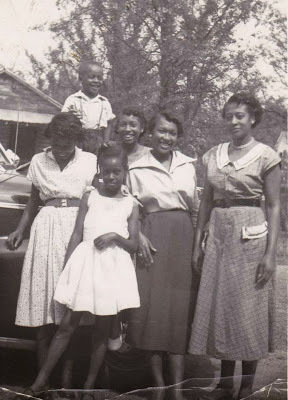 Sarah with her family (minus her father). She's the young lady in front,
Sarah with her family (minus her father). She's the young lady in front,
about nine years old.At one point their small house is vandalized. Sarah writes,
 Sarah's home in Sumter, SC She recalls the role of supportive teachers:
Sarah's home in Sumter, SC She recalls the role of supportive teachers: Sarah writes: "Lincoln Jr./Sr. High School on Council Street. Here, I learned the basics that allowed me to reach higher ground. It was also the place where teachers and classmates quenched my thirst.This school was not integrated until 1971."In an unusually frank conversation her mother admitted,
Sarah writes: "Lincoln Jr./Sr. High School on Council Street. Here, I learned the basics that allowed me to reach higher ground. It was also the place where teachers and classmates quenched my thirst.This school was not integrated until 1971."In an unusually frank conversation her mother admitted,
Sarah wrote, "Today I feel like she has exposed the rusty chain that holds her prisoner in Sumter." (p. 165-6)
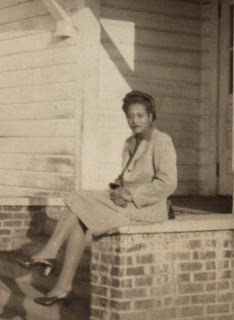 "My mother, the teacher"
"My mother, the teacher"
When Sarah is getting ready to make her debut she considers,
Sarah has no choice but to continue carrying out her plans. In 1963, she works as kitchen help in Vermont before entering college and receives an education:
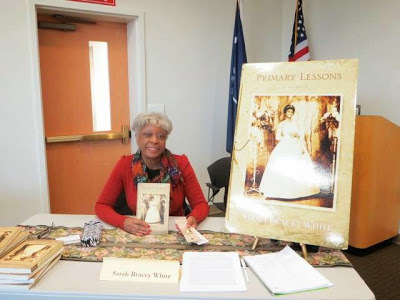 Sumter County Library Author's Fair
Sumter County Library Author's Fair
January, 2015
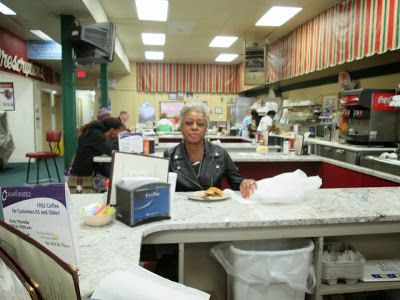 "Finally, a seat at the lunch counter."
"Finally, a seat at the lunch counter."
Sarah writes, "Places like this [a previously segregated lunch counter in Sumter, SC, ] are always a disappointment to me. We weren't missing anything. ….I wanted to see and document. I spoke with the two black women who have worked here for years." November, 2013
 Photo taken in 1963 at Sarah's Debutante Cotillion, age 17I don’t normally quote a press release when introducing a book, but I couldn’t improve on this synopsis of Sarah Bracey White’s memoir. I first “met” Sarah in the pages of Childrenof the Dream: Our Own Stories of Growing Up Black in America. After reading about her experiences as a Sumter, South Carolina teen working in a camp for wealthy New England girls, I friended her on Facebook and told her about my work-in-progress. She promptly sent me a copy of her memoir which, has since helped fuel writing
Half-Truths
. I think Sarah's memoir is best revealed in her own words.
Photo taken in 1963 at Sarah's Debutante Cotillion, age 17I don’t normally quote a press release when introducing a book, but I couldn’t improve on this synopsis of Sarah Bracey White’s memoir. I first “met” Sarah in the pages of Childrenof the Dream: Our Own Stories of Growing Up Black in America. After reading about her experiences as a Sumter, South Carolina teen working in a camp for wealthy New England girls, I friended her on Facebook and told her about my work-in-progress. She promptly sent me a copy of her memoir which, has since helped fuel writing
Half-Truths
. I think Sarah's memoir is best revealed in her own words.The city buses are a sore spot for me. We don’t have a car, and I seldom have a dime to ride the one that travels from Liberty Street downtown to the shopping area. Even if I did, I wouldn’t want to ride the bus because I hate sitting at the back. Maybe we are poor, but even if we had extra money, it wouldn’t change the thing I hate most: the fear colored adults exhibit toward white people, even white children. (p. 127)
 Sarah with her family (minus her father). She's the young lady in front,
Sarah with her family (minus her father). She's the young lady in front,about nine years old.At one point their small house is vandalized. Sarah writes,
Even though we had nothing of value, it’s frightening to think that strangers have spent the day in our house—on my bed. Why had they picked our house? Would they come back?... Why had they smashed them [the figurines]? Were they angry because they found no money or valuables? Whoever they were, they had to be colored. White boys stood out too much in a colored neighborhood to consider mischief like this. (p. 131)
 Sarah's home in Sumter, SC She recalls the role of supportive teachers:
Sarah's home in Sumter, SC She recalls the role of supportive teachers:Maybe my teachers like me because they can see that I’m an outsider, trying to fit into a life I don’t want. Or maybe they like me because they like my mama and know the hardships she endures. Whatever the reasons, my teachers are a source of comfort. They give me approval and confidence. By the time I reach high school, they no longer tell me to stop talking so much. In fact, they encourage my outspokenness and open doors that make it possible for me to use my gifts in ways that benefit me. (p. 142)
 Sarah writes: "Lincoln Jr./Sr. High School on Council Street. Here, I learned the basics that allowed me to reach higher ground. It was also the place where teachers and classmates quenched my thirst.This school was not integrated until 1971."In an unusually frank conversation her mother admitted,
Sarah writes: "Lincoln Jr./Sr. High School on Council Street. Here, I learned the basics that allowed me to reach higher ground. It was also the place where teachers and classmates quenched my thirst.This school was not integrated until 1971."In an unusually frank conversation her mother admitted, "Mama. . . Still young and hopeful. Roberta Bracey White"“The people in this town. They always said I wasn’t good enough for your daddy. He came from a fine respectable family, and I came from nothing. They used to say my real daddy was a white doctor who my mama worked for.
I’m shocked by Mama’s confession. “Is it true?” I ask.
“I don’t know. I was always scared to ask my mama about it. When I was about ten, I went over to the doctor’s house and hid behind a tree until he came home. I wanted to see if I looked like him.”
“Did you?”
“Not one bit! I didn’t look like my daddy either.” Mama pauses. Her eyes glaze, and she sighs deeply. “I loved my daddy. He used to call me his sunshine. Said I was the light of his life and that it was my job to banish the darkness. I never understood what he meant by that. I love the darkness. In the darkness, I’m the same color as everybody else.” (p. 164-5)When Sarah asked her mother why she didn’t move north like her siblings did, her mother replied, “When you move out of the south you leave your past behind. The only thing that counts up north is how much you got in your pocket. Everybody up north is running away from their past. The past is all I’ve got."
Sarah wrote, "Today I feel like she has exposed the rusty chain that holds her prisoner in Sumter." (p. 165-6)
 "My mother, the teacher"
"My mother, the teacher"When Sarah is getting ready to make her debut she considers,
Until those cotillion classes, I’d only been given instructions on what not to do. A long list of restrictions seemed to say that I was the problem, that my only for survival was to be invisible. But I don’t want to be invisible. I want to stand above the crowd and shine. That’s not the life plan for young colored girls like me. Yet being selected as a debutante has nurtured a rustling hope inside me. Maybe, just maybe, I can escape my fate.(p. 176)At the cotillion she thinks,
Tonight the fact that we're colored doesn't matter. Tonight I feel like a princess, smiled upon and feted by people I respect and who respect me. Tonight I'm more than just another poor little colored girl living in the shadows. I'm filled with the infinite possibilities of who I can become. (p.179)Sadly, two weeks after that special evening, Sarah's mother suddenly dies. At the funeral Sarah looks at her mother and thinks, "She looks more peaceful now than she ever looked alive." (p.197)
Sarah has no choice but to continue carrying out her plans. In 1963, she works as kitchen help in Vermont before entering college and receives an education:
When I ask Mrs. Lee [the woman who supervises the help] why we can't ride the horses or swim in the lake she smiles sadly and says, "We're the help, and the help doesn't mingle with the campers." Up north, it seems segregation is a matter of class and skin color.
In another conversation with Mrs. Lee Sarah questions why the white counselors make more money than she does, even though they are all "college girls."
Despite my anger at these restrictions, I am shamelessly curious about the campers. Never before have I been in such close proximity to so many white people. Daily it gets easier to eavesdrop on their conversations as they grow used to our brown presence and we become about as significant as the pine trees. No one worries about a pine tree hearing secrets. Soon I learn that white skin brings no solace from problems, that money doesn't ensure smooth boy-girl relationships or prevent sadness and heart ache. I also learn that white girls are cruel to other white girls. I had always assumed that whites were only cruel to colored people. I'm especially shocked to learn that white girls openly envy one another's looks. Almost every girl wants to be blond (I always thought long hair of any color was beautiful) and that every white girl would die for a perfect tan. I don't understand why they want to have skin like ours if they don't like colored people. (p.224)
Mrs. Lee shrugs, just the way Mama used to. "That's how life is," she says.
************Sarah is now the executive director of arts and culture in the town of Greensburgh, NY and teaches at the Hudson Valley Writers Center. For more information about how Sarah is busy "changing things," please visit her website.
I can't understand why adults accept everything. Just because that's the way it's always been doesn't mean that that's the way it should always be. When I get to be an adult, I'm gonna change things. (p.225)
 Sumter County Library Author's Fair
Sumter County Library Author's FairJanuary, 2015
 "Finally, a seat at the lunch counter."
"Finally, a seat at the lunch counter."Sarah writes, "Places like this [a previously segregated lunch counter in Sumter, SC, ] are always a disappointment to me. We weren't missing anything. ….I wanted to see and document. I spoke with the two black women who have worked here for years." November, 2013

Published on May 25, 2015 05:25
May 18, 2015
Who Is Your Audience?
Congratulations to Joyce Hostetter who won the audio book, "Red Berries, White Clouds, & Blue Sky" from last week's blog.
*******As some of you know, my husband and I recently went on a cross-country adventure. Seeing the northwest has been his bucket-list dream for years. Now that he is "semi-retired" we had the time to do it.
I’ll admit I wasn’t thrilled with the idea of driving from Florida to Seattle and back again, but it was amazing to see new parts of the country. Stationed in the backseat of our van along with my computer, Iphone, maps, books, and snacks, I enjoyed the ride and staying in touch with my world.
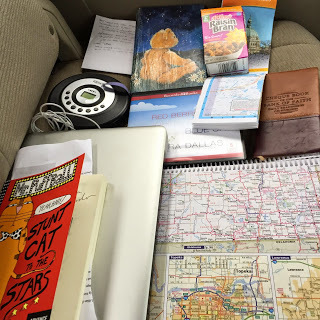
I also enjoyed sharing pictures via Facebook and texting. What can compare to seeing snow-covered mountains and texting them to my friends in the South and East? Mt. Ranier, Washington
Mt. Ranier, Washington
as seen through the car windowIt felt somewhat egotistical to share these pictures and I wanted to avoid a “look at me!” mentality, but I truly was blessed to have this opportunity. I was amazed at how many people looked at my pictures and commented on them or shared them with others.
A Facebook friend shared this image with her relative who teaches Renaissance Literature:
 Wichita, Ks. jordantarrant.com
Wichita, Ks. jordantarrant.com
Other friends laughed with me about the hullabaloo and long lines we witnessed in Bellevue, Washington when Seattle's first Chick-fil-A opened: http://www.seattletimes.com/seattle-n... of this made me consider the concept of audience.
http://www.seattletimes.com/seattle-n... of this made me consider the concept of audience.
When we share pictures, give a speech or performance; write an article or a book, we’re hoping for a positive reaction from our “audience.” Sometimes our audience surprises us.
With wind-blown hair, this picture of me taken in the Badlands National Park, South Dakota got more "likes" on Facebook than any other picture I posted.

My fellow blogger, Barbara Younger, blogs about menopause and all things related to women’s health in latter years. She has an occasional series showing women’s restroom doors. After spotting this door in The Canon Pub in Columbus, Georgia,
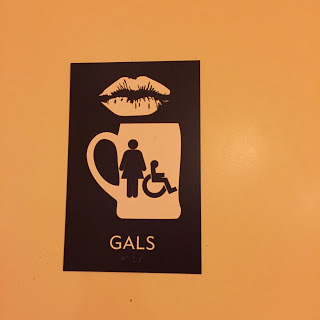
The hunt was on to send Barbra unusual ladies room doors. Here are two more I found. (BTW, I sent Barbara so many doors she's going to feature them on three separate blogs. Stay tuned!)
 At Worden's Deli in Missoula, Mt
At Worden's Deli in Missoula, Mt
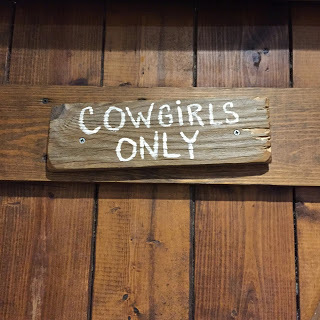 Colton's Steak House; Springfield, Mo
Colton's Steak House; Springfield, Mo
I knew my Korean friend Esther, who was recently confined to a wheel chair, would appreciate this sculpture

on a bike trail in Springfield, Missouri, as well as a Korean barbecue restaurant in an international food court outside Seattle.

I hoped my granddaughter would appreciate seeing the animals in Yellowstone,


And I knew my friend Linda Phillips would appreciate this image from her home state of Oregon:
 Multnomah Falls, Oregon
Multnomah Falls, Oregon
Having an audience added unanticipated fun to my trip. But at some point I started wondering: do I take pictures--or write a book--to please an audience? And as flattering as "likes" are on Facebook or "favorites" on Twitter can be--am I writing to say something or to please an audience?
I’ve heard that it’s a good idea to write your book picturing your target reader. Do you agree? If you are writing a book, are you writing with a specific audience in mind? If you've already published books, is your audience who you expected it would be?
Take a look at Augusta Scattergood's blog post on a similar topic.
What do you think? Has anticipating your audience shaped your work? If so, has that been a good or bad experience for you?
Meanwhile, thank you, blog readers and Facebook friends, for being a kind, supportive audience. This picture is for you:
 Coeur D'Alene, Idaho
Coeur D'Alene, Idaho

*******As some of you know, my husband and I recently went on a cross-country adventure. Seeing the northwest has been his bucket-list dream for years. Now that he is "semi-retired" we had the time to do it.
I’ll admit I wasn’t thrilled with the idea of driving from Florida to Seattle and back again, but it was amazing to see new parts of the country. Stationed in the backseat of our van along with my computer, Iphone, maps, books, and snacks, I enjoyed the ride and staying in touch with my world.

I also enjoyed sharing pictures via Facebook and texting. What can compare to seeing snow-covered mountains and texting them to my friends in the South and East?
 Mt. Ranier, Washington
Mt. Ranier, Washingtonas seen through the car windowIt felt somewhat egotistical to share these pictures and I wanted to avoid a “look at me!” mentality, but I truly was blessed to have this opportunity. I was amazed at how many people looked at my pictures and commented on them or shared them with others.
A Facebook friend shared this image with her relative who teaches Renaissance Literature:
 Wichita, Ks. jordantarrant.com
Wichita, Ks. jordantarrant.comOther friends laughed with me about the hullabaloo and long lines we witnessed in Bellevue, Washington when Seattle's first Chick-fil-A opened:
 http://www.seattletimes.com/seattle-n... of this made me consider the concept of audience.
http://www.seattletimes.com/seattle-n... of this made me consider the concept of audience.When we share pictures, give a speech or performance; write an article or a book, we’re hoping for a positive reaction from our “audience.” Sometimes our audience surprises us.
With wind-blown hair, this picture of me taken in the Badlands National Park, South Dakota got more "likes" on Facebook than any other picture I posted.

My fellow blogger, Barbara Younger, blogs about menopause and all things related to women’s health in latter years. She has an occasional series showing women’s restroom doors. After spotting this door in The Canon Pub in Columbus, Georgia,

The hunt was on to send Barbra unusual ladies room doors. Here are two more I found. (BTW, I sent Barbara so many doors she's going to feature them on three separate blogs. Stay tuned!)
 At Worden's Deli in Missoula, Mt
At Worden's Deli in Missoula, Mt Colton's Steak House; Springfield, Mo
Colton's Steak House; Springfield, MoI knew my Korean friend Esther, who was recently confined to a wheel chair, would appreciate this sculpture

on a bike trail in Springfield, Missouri, as well as a Korean barbecue restaurant in an international food court outside Seattle.

I hoped my granddaughter would appreciate seeing the animals in Yellowstone,


And I knew my friend Linda Phillips would appreciate this image from her home state of Oregon:
 Multnomah Falls, Oregon
Multnomah Falls, OregonHaving an audience added unanticipated fun to my trip. But at some point I started wondering: do I take pictures--or write a book--to please an audience? And as flattering as "likes" are on Facebook or "favorites" on Twitter can be--am I writing to say something or to please an audience?
I’ve heard that it’s a good idea to write your book picturing your target reader. Do you agree? If you are writing a book, are you writing with a specific audience in mind? If you've already published books, is your audience who you expected it would be?
Take a look at Augusta Scattergood's blog post on a similar topic.
What do you think? Has anticipating your audience shaped your work? If so, has that been a good or bad experience for you?
Meanwhile, thank you, blog readers and Facebook friends, for being a kind, supportive audience. This picture is for you:
 Coeur D'Alene, Idaho
Coeur D'Alene, Idaho
Published on May 18, 2015 03:00
May 11, 2015
Red Berries, White Clouds, Blue Sky by Sandra Dallas: A Review and Giveaway
Congratulations to Sheri Levy who won an autographed copy of "Mr. Puffball: Stunt Cat to the Stars."
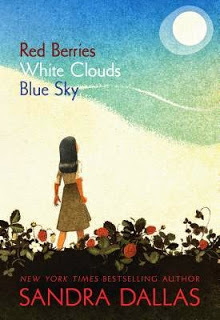
The year is 1942 and for 12-year-old Tomi Itano, a second-generation Japanese-American, life is about to change. Tomi loves everything about her home: the strawberries her father grows on their farm, her Girl Scout troop, her Japanese doll, which her grandparents sent her, and the American flag, which her father proudly salutes every day.
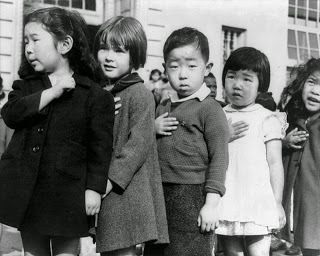 JapaneseAmericansChildrenPledgingAllegiance1942-2 by Photo attributed to Dorothea Lange(w). Via US Library of CongressFarm Security Administration and Office of War Information Collection
JapaneseAmericansChildrenPledgingAllegiance1942-2 by Photo attributed to Dorothea Lange(w). Via US Library of CongressFarm Security Administration and Office of War Information Collection
(Library of Congress). CALL NUMBER: LOT 1801But amidst the paranoia of World War II, when Japanese newspapers and letters from home, are “proof” of being an enemy spy, the Itano’s become victims of fear, prejudice, and false accusations. Tomi’s father is arrested and taken to prison. After President Roosevelt signs Executive Order 9066 ordering thousands of Japanese to be relocated, Mrs. Itano and her three children are taken to a series of interment camps. They finally are taken to Tall Grass, Colorado (a fictionalized camp based on Hamache) where they are forced to make a 16 x 20 square foot room their apartment.
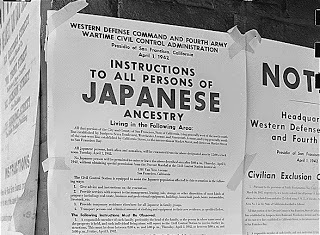 Posted Japanese American Exclusion Order" by Department of the Interior. War Relocation Authority
Posted Japanese American Exclusion Order" by Department of the Interior. War Relocation Authority
This media is available in the holdings of the National Archives and Records Administration, cataloged under the ARC Identifier (National Archives Identifier) 536017 .Despite always worrying how Mr. Itano will find them, the family adjusts to camp life. Although they don’t want to be there, the children gain friends and Mrs. Itano blossoms in her new role as a quilting teacher. Interactions with the local townspeople add more spice to the story. When Dennis, a boy Tomi meets, confronts her on being “un-American” because of how she looks, she retaliates in anger. Discovering he is the son of a German immigrant, she questions if everyone should be rounded up and shipped to a camp just because they all don’t look alike. His changed attitude towards the Japanese would be a great teaching point for teachers using this book in an upper elementary/middle school classroom.
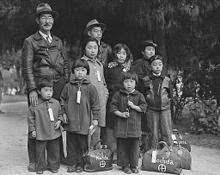 Original caption: Hayward, California. Members of the Mochida family awaiting evacuation bus. Identification tags are used to aid in keeping the family unit intact during all phases of evacuation. Mochida operated a nursery and five greenhouses on a two-acre site in Eden Township. He raised snapdragons and sweet peas.
Original caption: Hayward, California. Members of the Mochida family awaiting evacuation bus. Identification tags are used to aid in keeping the family unit intact during all phases of evacuation. Mochida operated a nursery and five greenhouses on a two-acre site in Eden Township. He raised snapdragons and sweet peas.
When Mr. Itano is finally reunited with the family, he is a different man. Being unfairly imprisoned has left him bitter. His love for the country he chose is replaced with anger and apathy. On top of that, his family has changed. His wife is no longer silent and submissive, his family doesn’t eat together, and his son wants to join the army. Unfortunately, his bitterness infects Tomi and her outlook changes also. Not until Tomi writes a prize-winning essay on “Why I am an American” based on her father’s immigrant hopes and dreams, do her and her father’s attitudes change.
I was most captivated by Tomi’s mother. Faced with the challenges of being a mail-order bride, raising a family in a foreign country, being shuttled from one interment camp to another, and then a bumpy reunion with her husband who is unhappy with her Americanization—she showed the most endurance and strength. Her authentic response to difficulties was the glue that kept her family together.
The book is recommended for reader ages 8 and up. I think that an 8-year-old would be too young to appreciate and learn from this story; I believe it is more suitable for boys and girls who are at least 10-year-old. Red Berries, White Clouds, Blue Sky is Sandra Dallas' second book about a terrible period in our nation’s history, and can be a valuable classroom supplement. Jennifer Ikeda, the narrator of the audio book, did a good job creating the Japanese and American voices.
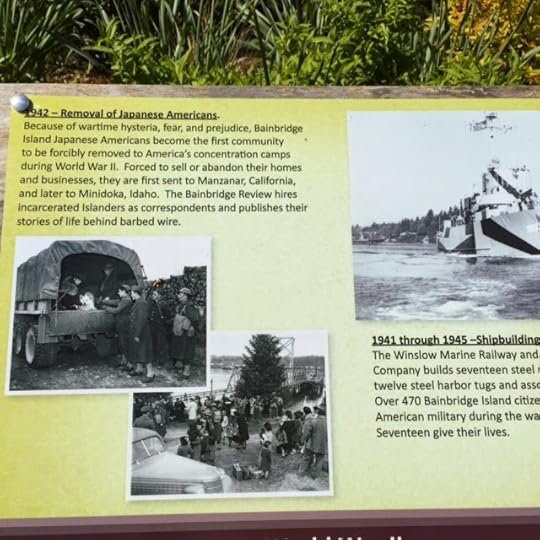
I took this picture on a recent trip to Bainbridge Island near Seattle Seattle. Then I found this on the same Wikipedia site where I found all of the black and white images.
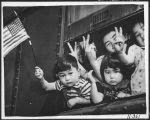 Bainbridge Island (Wash.) evacuation -- Group of young evacuees wave from
Bainbridge Island (Wash.) evacuation -- Group of young evacuees wave from
special train as it leaves Seattle with Island evacuees, March 30, 1942By the way, the 442nd Infantry Regiment which Tomi's brother joined, was composed of almost entirely of Japanese Americans whose families were in interment camps. It was the most decorated unit for its size and length of service in the history of American warfare.
Thanks to the generosity of Recorded Books, I am able to offer this audiobook to a blog reader. Please leave me a comment by May 14 and I’ll enter your name in the giveaway. It will be a great addition to a school or homeschool library.


The year is 1942 and for 12-year-old Tomi Itano, a second-generation Japanese-American, life is about to change. Tomi loves everything about her home: the strawberries her father grows on their farm, her Girl Scout troop, her Japanese doll, which her grandparents sent her, and the American flag, which her father proudly salutes every day.
 JapaneseAmericansChildrenPledgingAllegiance1942-2 by Photo attributed to Dorothea Lange(w). Via US Library of CongressFarm Security Administration and Office of War Information Collection
JapaneseAmericansChildrenPledgingAllegiance1942-2 by Photo attributed to Dorothea Lange(w). Via US Library of CongressFarm Security Administration and Office of War Information Collection(Library of Congress). CALL NUMBER: LOT 1801But amidst the paranoia of World War II, when Japanese newspapers and letters from home, are “proof” of being an enemy spy, the Itano’s become victims of fear, prejudice, and false accusations. Tomi’s father is arrested and taken to prison. After President Roosevelt signs Executive Order 9066 ordering thousands of Japanese to be relocated, Mrs. Itano and her three children are taken to a series of interment camps. They finally are taken to Tall Grass, Colorado (a fictionalized camp based on Hamache) where they are forced to make a 16 x 20 square foot room their apartment.
 Posted Japanese American Exclusion Order" by Department of the Interior. War Relocation Authority
Posted Japanese American Exclusion Order" by Department of the Interior. War Relocation AuthorityThis media is available in the holdings of the National Archives and Records Administration, cataloged under the ARC Identifier (National Archives Identifier) 536017 .Despite always worrying how Mr. Itano will find them, the family adjusts to camp life. Although they don’t want to be there, the children gain friends and Mrs. Itano blossoms in her new role as a quilting teacher. Interactions with the local townspeople add more spice to the story. When Dennis, a boy Tomi meets, confronts her on being “un-American” because of how she looks, she retaliates in anger. Discovering he is the son of a German immigrant, she questions if everyone should be rounded up and shipped to a camp just because they all don’t look alike. His changed attitude towards the Japanese would be a great teaching point for teachers using this book in an upper elementary/middle school classroom.
 Original caption: Hayward, California. Members of the Mochida family awaiting evacuation bus. Identification tags are used to aid in keeping the family unit intact during all phases of evacuation. Mochida operated a nursery and five greenhouses on a two-acre site in Eden Township. He raised snapdragons and sweet peas.
Original caption: Hayward, California. Members of the Mochida family awaiting evacuation bus. Identification tags are used to aid in keeping the family unit intact during all phases of evacuation. Mochida operated a nursery and five greenhouses on a two-acre site in Eden Township. He raised snapdragons and sweet peas. When Mr. Itano is finally reunited with the family, he is a different man. Being unfairly imprisoned has left him bitter. His love for the country he chose is replaced with anger and apathy. On top of that, his family has changed. His wife is no longer silent and submissive, his family doesn’t eat together, and his son wants to join the army. Unfortunately, his bitterness infects Tomi and her outlook changes also. Not until Tomi writes a prize-winning essay on “Why I am an American” based on her father’s immigrant hopes and dreams, do her and her father’s attitudes change.
I was most captivated by Tomi’s mother. Faced with the challenges of being a mail-order bride, raising a family in a foreign country, being shuttled from one interment camp to another, and then a bumpy reunion with her husband who is unhappy with her Americanization—she showed the most endurance and strength. Her authentic response to difficulties was the glue that kept her family together.
The book is recommended for reader ages 8 and up. I think that an 8-year-old would be too young to appreciate and learn from this story; I believe it is more suitable for boys and girls who are at least 10-year-old. Red Berries, White Clouds, Blue Sky is Sandra Dallas' second book about a terrible period in our nation’s history, and can be a valuable classroom supplement. Jennifer Ikeda, the narrator of the audio book, did a good job creating the Japanese and American voices.

I took this picture on a recent trip to Bainbridge Island near Seattle Seattle. Then I found this on the same Wikipedia site where I found all of the black and white images.
 Bainbridge Island (Wash.) evacuation -- Group of young evacuees wave from
Bainbridge Island (Wash.) evacuation -- Group of young evacuees wave from special train as it leaves Seattle with Island evacuees, March 30, 1942By the way, the 442nd Infantry Regiment which Tomi's brother joined, was composed of almost entirely of Japanese Americans whose families were in interment camps. It was the most decorated unit for its size and length of service in the history of American warfare.
Thanks to the generosity of Recorded Books, I am able to offer this audiobook to a blog reader. Please leave me a comment by May 14 and I’ll enter your name in the giveaway. It will be a great addition to a school or homeschool library.

Published on May 11, 2015 03:00
May 4, 2015
Mr. Puffball: Stunt Cat to the Stars -- A Review and ARC GIveaway
Hands (or I should say paws) down, Constance Lombardo’s love for all things feline shine through her fun illustrations and text in
Mr. Puffball: Stunt Cat to the Stars
, an entertaining graphic novel for readers from grades 3-7. Constance admits that Mr. Puffball is a mix of all the cats she’s ever loved. “Cats have funny, pensive faces, come in so many different colors, stripes, patches, etc. I can't look at a cat without imagining a speech bubble. They've got lots of personality and like to do their own thing and most of them do want to be movie stars!”
Mr. Puffball’s egotistic-yet-adorable voice is communicated in the opening lines. “My name is Mr. Puffball, and this is my story. It all started in a little town called New Jersey, home to such famous American landmarks as my house.”
His life is changed forever when he sees the movie, Cow-Cats & Aliens starring El Gato. From that moment on, this precocious kitten decides he must become a movie star. Despite nay-sayers among his siblings, his mother fuels his dream by telling him about his great-grandmother Zelda, a star in Cleocatra meets The Mummy.
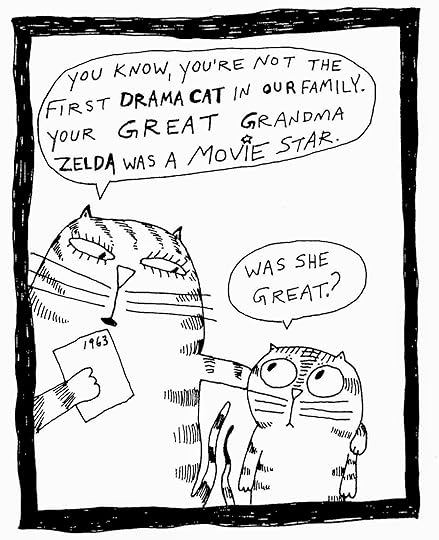

That’s all the inspiration Mr. Puffball needs. With his tiny replica of Mr. Gato tucked into a cloth waistband and a newspaper ad for a movie audition for The Great Catsby, Mr. Puffball leaves for Hollywood and sends postcards home to his mother.
Having just experienced a recent close run-in with Kansas tornadoes, I appreciated this illustration:
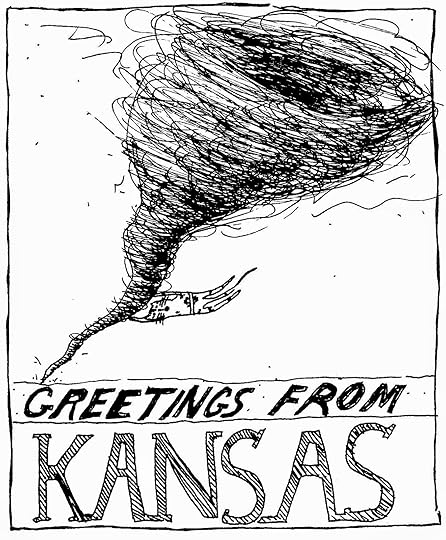
Unfortunately, fame and fortune don’t come as easily as expected. Metro-Olden Meower studios is closed and Mr. Puffball is twenty years late for the audition. His audition at Purramount Studios falls flat. But when Chester Grumpus (the producer of such great movies as The Sound of Meowsicand Attack of the 50 Foot She-Cat) takes him under his wing (err…his paw), Mr. Puffball meets three friends who help get his career off the ground.
Despite his excellent audition in Nine Lives to Live, Mr. Puffball only receives a part as an extra. Nine Lives is “a classic western with handsome heroes, sinister villains, and old-fashioned rattlesnakes… [the hero] El Gato is after Billy the Kitten, who square-danced with El Gato’s one true love, Veronica, even though she prefers ballroom...They steal Billy the Kitten’s ten-gallon hat, which turns out to only hold five gallons. Laughing about their misadventure, El Gato and Veronica ride into the sunset where they hope to open a hotel with a water slide.” (p. 96)
Determined to make El Gato notice him, Mr. Puffball lands himself a job as his stunt cat and becomes Bruiser’s prodigy: “Ride bad-temper horse now! Going backward! Faster! Don’t fall or you be trampled. See what I tell you?” (Hmm… Wonder whose dialogue Constance mimicked here?)

Hilarious scenes ensue that both children and adults will enjoy. Mr. Puffball rides in El Gato’s limousine equipped not only with cup holders and a mini fridge, but also a climbing wall and catnip. At a night out at the Brown Tabby, he eats fish tacos, plays with Wacky String, and meets Rosie, a (cute!) fellow Kung Fu Kitty.
Although the illustrations will draw readers in, the "a-hero-isn’t-always-who-he-appear-to-be" plot is clever and inspirational. Mr. Puffball’s adventure culminates at the opening night of Nine Lives.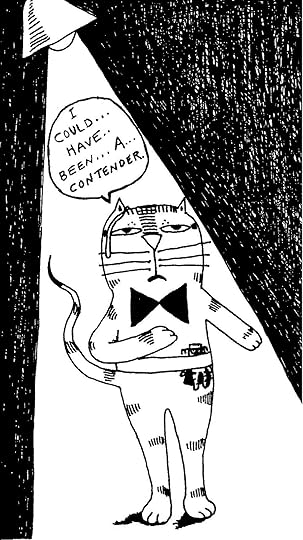
Constance finishes the story with a flourish, a flash-mob, and a glossary that made me laugh out loud. I can't wait for the sequel--fortunately, she is already working on it. Constance writes, “In the next two books, Mr. Puffball will continue pursuing his biggest dream: to be a movie star! Wherever he may travel, whatever television, modeling, stunt or corporate work he takes on, he always keeps his eyes on the Oscar!”
I don’t want to spoil this book for you. Let me suggest you catapult this book onto your “to be read list” and discover a catacophony of puns and a memorable story about a remarkable tabby cat. One way to support debut authors is by pre-ordering their books. I’m pre-ordering two copies of Mr. Puffball, one for each set of my grandkids. I bet you also know a girl or boy who would cheer Mr. Puffball on his journey to fame and fortune.
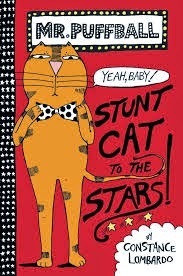
To enter to win an autographed copy of my well-loved ARC, please leave me a comment along with your email address if you’re new to my blog. Tag me on Twitter (cbaldwinCarol) or Facebook (Carol Federlin Baldwin) or become a new follower, and I’ll enter your name for each one. Random.org will pick a winner on May 7.
Mr. Puffball’s egotistic-yet-adorable voice is communicated in the opening lines. “My name is Mr. Puffball, and this is my story. It all started in a little town called New Jersey, home to such famous American landmarks as my house.”
His life is changed forever when he sees the movie, Cow-Cats & Aliens starring El Gato. From that moment on, this precocious kitten decides he must become a movie star. Despite nay-sayers among his siblings, his mother fuels his dream by telling him about his great-grandmother Zelda, a star in Cleocatra meets The Mummy.


That’s all the inspiration Mr. Puffball needs. With his tiny replica of Mr. Gato tucked into a cloth waistband and a newspaper ad for a movie audition for The Great Catsby, Mr. Puffball leaves for Hollywood and sends postcards home to his mother.
Having just experienced a recent close run-in with Kansas tornadoes, I appreciated this illustration:

Unfortunately, fame and fortune don’t come as easily as expected. Metro-Olden Meower studios is closed and Mr. Puffball is twenty years late for the audition. His audition at Purramount Studios falls flat. But when Chester Grumpus (the producer of such great movies as The Sound of Meowsicand Attack of the 50 Foot She-Cat) takes him under his wing (err…his paw), Mr. Puffball meets three friends who help get his career off the ground.
Despite his excellent audition in Nine Lives to Live, Mr. Puffball only receives a part as an extra. Nine Lives is “a classic western with handsome heroes, sinister villains, and old-fashioned rattlesnakes… [the hero] El Gato is after Billy the Kitten, who square-danced with El Gato’s one true love, Veronica, even though she prefers ballroom...They steal Billy the Kitten’s ten-gallon hat, which turns out to only hold five gallons. Laughing about their misadventure, El Gato and Veronica ride into the sunset where they hope to open a hotel with a water slide.” (p. 96)
Determined to make El Gato notice him, Mr. Puffball lands himself a job as his stunt cat and becomes Bruiser’s prodigy: “Ride bad-temper horse now! Going backward! Faster! Don’t fall or you be trampled. See what I tell you?” (Hmm… Wonder whose dialogue Constance mimicked here?)

Hilarious scenes ensue that both children and adults will enjoy. Mr. Puffball rides in El Gato’s limousine equipped not only with cup holders and a mini fridge, but also a climbing wall and catnip. At a night out at the Brown Tabby, he eats fish tacos, plays with Wacky String, and meets Rosie, a (cute!) fellow Kung Fu Kitty.
Although the illustrations will draw readers in, the "a-hero-isn’t-always-who-he-appear-to-be" plot is clever and inspirational. Mr. Puffball’s adventure culminates at the opening night of Nine Lives.

Constance finishes the story with a flourish, a flash-mob, and a glossary that made me laugh out loud. I can't wait for the sequel--fortunately, she is already working on it. Constance writes, “In the next two books, Mr. Puffball will continue pursuing his biggest dream: to be a movie star! Wherever he may travel, whatever television, modeling, stunt or corporate work he takes on, he always keeps his eyes on the Oscar!”
I don’t want to spoil this book for you. Let me suggest you catapult this book onto your “to be read list” and discover a catacophony of puns and a memorable story about a remarkable tabby cat. One way to support debut authors is by pre-ordering their books. I’m pre-ordering two copies of Mr. Puffball, one for each set of my grandkids. I bet you also know a girl or boy who would cheer Mr. Puffball on his journey to fame and fortune.

To enter to win an autographed copy of my well-loved ARC, please leave me a comment along with your email address if you’re new to my blog. Tag me on Twitter (cbaldwinCarol) or Facebook (Carol Federlin Baldwin) or become a new follower, and I’ll enter your name for each one. Random.org will pick a winner on May 7.

Published on May 04, 2015 03:00
April 27, 2015
You Heard it Here First: Introducing Constance Lombardo and Mr. Puffball
Congratulations to Peggy Rothschild, a new blog reader, who won Susan Moger's book, Teaching the Diary of Anne Frank.
*******I love introducing new authors and illustrators and sharing news of upcoming publications. This time, Constance Lombardo, a writer/illustrator in the SCBWI-Carolinas region, takes center stage with her debut graphic novel. This week you'll hear about her path to publication; next week I'll review her book and give away an autographed copy of her ARC.
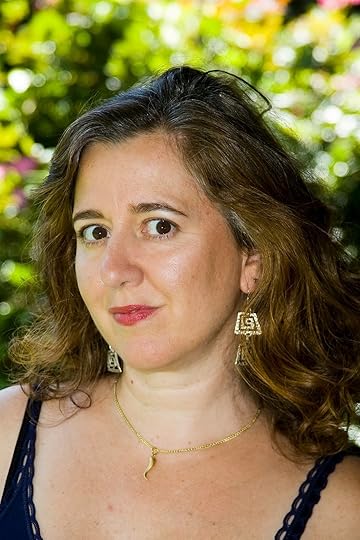 Photo by Chris ChromeyCAROL: Tell us a little about yourself. Your background, your dreams, how long you've been at the "I want to publish a book!" business. Did you go to school for writing or illustrating?
Photo by Chris ChromeyCAROL: Tell us a little about yourself. Your background, your dreams, how long you've been at the "I want to publish a book!" business. Did you go to school for writing or illustrating?
CONSTANCE: I got my BFA in Illustration from Syracuse University many moons ago. After graduation, I took painting, printmaking, writing, and pottery classes. I interned with a renowned community muralist in San Francisco. I drew and painted and was in gallery shows in San Francisco and New York.
CAROL: How did you get into writing children’s books?
CONSTANCE: When I had my baby, I read her my favorite picture books and realized that was what I wanted to do. When I was very little, I told my dad I wanted to make ‘books with drawings in them.’ It took me a while to get back to that dream!
CAROL: What steps did you take to make this dream come true?
CONSTANCE: I subbed my first book – a picture book called The Sky is Where the Sun Lives in 2003. In the following years, I wrote many picture books, two YA novels, and one MG novel. I joined SCBWI and attended several regional conferences and one national conference in NYC where I learned SO MUCH about writing, editing, publishing and networking. I formed a critique group in Asheville (The Secret Gardeners) and with the help of these resources I continued to grow as a writer and improve my skills to get to the next level. Highlights magazine bought one of my stories (as yet unpublished,) Humpty Dumpty’s magazine published one of my poems, and my illustrations have appeared in magazines (SCBWI Bulletin, New Moon Moon Girls) and on cd covers.
In 2011, I started drawing cats without a specific project in mind. Drawings led to comic strip panels, which led to a more realized narrative starring one irrepressible feline: Mr. Puffball. He wanted to go to Hollywood. He was naïve but optimistic (like me!) And he wanted a bow tie.
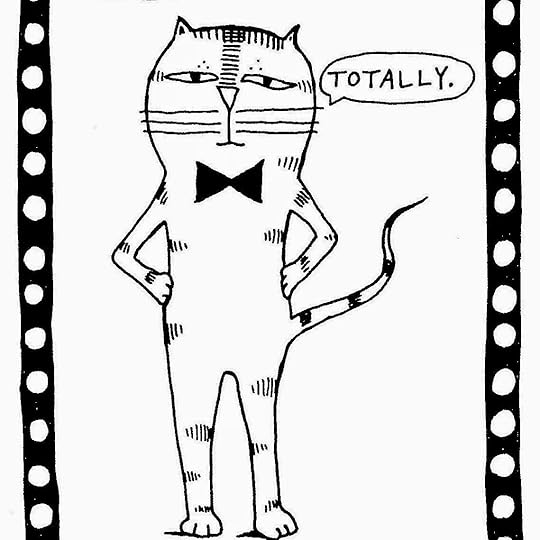
In 2012, SCBWI Carolinas hosted a Graphic Novel Workshop by Mark Siegel (Editorial Director, First Second Books) in Asheville, NC. (Thanks, SCBWI Carolinas!!) The timing could not have been more perfect. I got motivated to finish a rough draft, attended this wonderful workshop, learned a lot and left eager to submit my graphic novel.
CAROL: How did you find your agent and your publisher?
CONSTANCE: I began subbing and got some of the most positive feedback I’d ever received. I had subbed some picture books to the fabulous Lori Nowicki of Painted Words, and she expressed interest in seeing more. When I subbed my graphic novel, Lori seemed really interested and scheduled a phone date (Hooray!) I had subbed to agents for years, but this was my first phone call. Was I nervous! Fortunately, Lori and I really hit it off - she loved Mr. Puffball and gave me some excellent editorial guidance. I followed her suggestions and, a few months later, we signed!
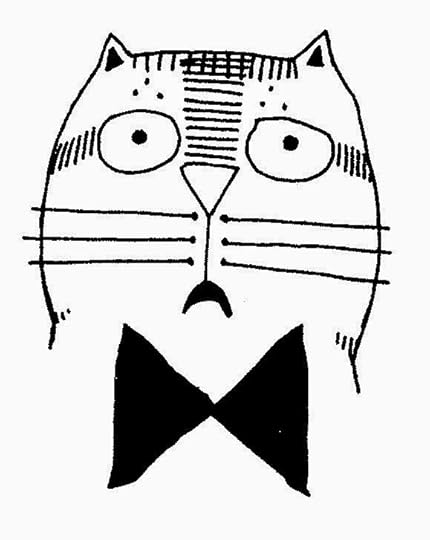
Within a few months, she connected me with my amazing editor, Jill Davis at Katherine Tegen Books/HarperCollins. Jill loved Mr. Puffball but wanted to see the book changed to an illustrated MG novel format (like Diary of a Wimpy Kid or Big Nate.) I went with that idea and loved where it took me. Jill showed it around Katherine Tegen Books, rooting for me all the way, and we soon signed a three book contract. The first Mr. Puffball comes out fall 2015, the second in 2016, and then the last in 2017. Yay!!! I am so lucky to work with Jill Davis. Now I know what it means to have a truly excellent editor – because of her, my novel is tons better than I ever could have imagined. (Thanks for bringing us together, Lori Nowicki!)
CAROL: That’s so exciting! Where are you in this process?CONSTANCE: I am currently working on the 2nd book. I love combining words and pictures and see myself working in this format on future projects. I would love to do a YA graphic novel or illustrated novel. And I still hope to publish a picture book or two (or three or four!) one day.
Next week I'll be posting a review of Constance's book and offer you a chance to win her ARC. Meanwhile, here's the synopsis:
In the illustrated middle grade novel, Mr. Puffball: Stunt Cat to the Stars by Constance Lombardo (Katherine Tegen Books, HarperCollins Children’s Books, fall 2015,) Mr. Puffball leaves his New Jersey home on a cross country trip (with postcards home to Mom!) to make his movie star dreams come true. When he lands in Hollywood, Mr. Puffball catapults himself into the next best thing to being a famous movie star: working as a stunt cat to his movie star hero, El Gato! (with over 200 drawings!)


*******I love introducing new authors and illustrators and sharing news of upcoming publications. This time, Constance Lombardo, a writer/illustrator in the SCBWI-Carolinas region, takes center stage with her debut graphic novel. This week you'll hear about her path to publication; next week I'll review her book and give away an autographed copy of her ARC.
 Photo by Chris ChromeyCAROL: Tell us a little about yourself. Your background, your dreams, how long you've been at the "I want to publish a book!" business. Did you go to school for writing or illustrating?
Photo by Chris ChromeyCAROL: Tell us a little about yourself. Your background, your dreams, how long you've been at the "I want to publish a book!" business. Did you go to school for writing or illustrating?CONSTANCE: I got my BFA in Illustration from Syracuse University many moons ago. After graduation, I took painting, printmaking, writing, and pottery classes. I interned with a renowned community muralist in San Francisco. I drew and painted and was in gallery shows in San Francisco and New York.
CAROL: How did you get into writing children’s books?
CONSTANCE: When I had my baby, I read her my favorite picture books and realized that was what I wanted to do. When I was very little, I told my dad I wanted to make ‘books with drawings in them.’ It took me a while to get back to that dream!
CAROL: What steps did you take to make this dream come true?
CONSTANCE: I subbed my first book – a picture book called The Sky is Where the Sun Lives in 2003. In the following years, I wrote many picture books, two YA novels, and one MG novel. I joined SCBWI and attended several regional conferences and one national conference in NYC where I learned SO MUCH about writing, editing, publishing and networking. I formed a critique group in Asheville (The Secret Gardeners) and with the help of these resources I continued to grow as a writer and improve my skills to get to the next level. Highlights magazine bought one of my stories (as yet unpublished,) Humpty Dumpty’s magazine published one of my poems, and my illustrations have appeared in magazines (SCBWI Bulletin, New Moon Moon Girls) and on cd covers.
In 2011, I started drawing cats without a specific project in mind. Drawings led to comic strip panels, which led to a more realized narrative starring one irrepressible feline: Mr. Puffball. He wanted to go to Hollywood. He was naïve but optimistic (like me!) And he wanted a bow tie.

In 2012, SCBWI Carolinas hosted a Graphic Novel Workshop by Mark Siegel (Editorial Director, First Second Books) in Asheville, NC. (Thanks, SCBWI Carolinas!!) The timing could not have been more perfect. I got motivated to finish a rough draft, attended this wonderful workshop, learned a lot and left eager to submit my graphic novel.
CAROL: How did you find your agent and your publisher?
CONSTANCE: I began subbing and got some of the most positive feedback I’d ever received. I had subbed some picture books to the fabulous Lori Nowicki of Painted Words, and she expressed interest in seeing more. When I subbed my graphic novel, Lori seemed really interested and scheduled a phone date (Hooray!) I had subbed to agents for years, but this was my first phone call. Was I nervous! Fortunately, Lori and I really hit it off - she loved Mr. Puffball and gave me some excellent editorial guidance. I followed her suggestions and, a few months later, we signed!

Within a few months, she connected me with my amazing editor, Jill Davis at Katherine Tegen Books/HarperCollins. Jill loved Mr. Puffball but wanted to see the book changed to an illustrated MG novel format (like Diary of a Wimpy Kid or Big Nate.) I went with that idea and loved where it took me. Jill showed it around Katherine Tegen Books, rooting for me all the way, and we soon signed a three book contract. The first Mr. Puffball comes out fall 2015, the second in 2016, and then the last in 2017. Yay!!! I am so lucky to work with Jill Davis. Now I know what it means to have a truly excellent editor – because of her, my novel is tons better than I ever could have imagined. (Thanks for bringing us together, Lori Nowicki!)
CAROL: That’s so exciting! Where are you in this process?CONSTANCE: I am currently working on the 2nd book. I love combining words and pictures and see myself working in this format on future projects. I would love to do a YA graphic novel or illustrated novel. And I still hope to publish a picture book or two (or three or four!) one day.
Next week I'll be posting a review of Constance's book and offer you a chance to win her ARC. Meanwhile, here's the synopsis:
In the illustrated middle grade novel, Mr. Puffball: Stunt Cat to the Stars by Constance Lombardo (Katherine Tegen Books, HarperCollins Children’s Books, fall 2015,) Mr. Puffball leaves his New Jersey home on a cross country trip (with postcards home to Mom!) to make his movie star dreams come true. When he lands in Hollywood, Mr. Puffball catapults himself into the next best thing to being a famous movie star: working as a stunt cat to his movie star hero, El Gato! (with over 200 drawings!)


Published on April 27, 2015 03:00
April 20, 2015
Teaching the Diary of Anne Frank: A Review and a Giveaway!
The first thing I noticed about Susan Moger’s book, Teaching the Diary of Anne Frank: An In-Depth Resource for Learning About the Holocaust Through the Writings of Anne Frank was her personal connection to Anne’s story. Here are the opening words to the preface:
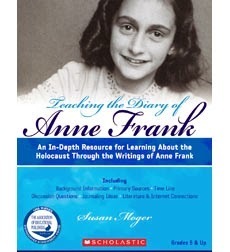
Ms. Moger worked hard to show the historical context of Anne Frank’s life. But that broad worldview is balanced with personal snapshots showing how Anne was a “normal” teenager in an abnormal time. The book's timeline reflects this by showing what was going on in the Frank family in correspondence with world events.
Each of the five chapters incorporate resource pages amplifying the author's mission: to teach young people about the Holocaust so that Anne Frank's legacy will influence present and future generations.
You'll have to get the book to appreciate the depth of resources which Susan assembled in this curriculum resource. I can't begin to showcase her project suggestions, response journal topics, thought provoking discussion questions, and excerpts from Holocaust survivors. Here are just a few examples which spoke to me.
MAPS http://www.theholocaustexplained.org/... map is similar to the one reproduced in the book. If you click on this website you can see a succession of maps showing the progression of German occupation.
http://www.theholocaustexplained.org/... map is similar to the one reproduced in the book. If you click on this website you can see a succession of maps showing the progression of German occupation.
PHOTOGRAPHS http://www.annefrank.ch/diary.html
http://www.annefrank.ch/diary.html
This photograph captures Anne and her dream of one day becoming a journalist or a writer.
DOCUMENTS
National-Socialist German Workers' PartyParty SecretariatHead of the Party Secretariat Fuehrer Headquarters, July 11, 1943 Circular No. 33/43 g.
Re: Treatment of the Jewish Question
On instructions from the Fuehrer I make known the following:Where the Jewish Question is brought up in public, there may be no discussion of a future overall solution.
It may, however, be mentioned that the Jews are taken in groups for appropriate labor purposes.
signed M. Bormann
Distribution: ReichsleiterGauleiterGroup leadersFile Reference: Treatment/Jews
Source: Documents on the Holocaust, Selected Sources on theDestruction of the Jews of Germany and Austria, Poland and the Soviet
Union, Yad Vashem, Jerusalem, 1981, Document no.160. p.342.
This is one of several documents used in the prosecution of Nazi war criminals during the Nuremberg trials. Ms. Moger also devotes several resource pages and discussion questions on the topic of doublespeak and euphemisms.
LITERATURE
A Dead Child Speaks
by Nelly Sachs
My mother held me by my hand.Then someone raised the knife of parting:So that it should not strike me,My mother loosed her hand from mine.But she lightly touched my thighs once moreAnd her hand was bleeding –
After that the knife of partingCut in two each bite I swallowed –It rose before me with the sun at dawnAnd began to sharpen itself in my eyes –Wind and water ground in my earAnd every voice of comfort pierced my heart –
As I was led to deathI still felt in the last momentThe unsheathing of the great knife of parting.
(Translated by Ruth &Matthew Mead)Holocaust Poetry: Compiled and Introduced by Hilda Schiff.
PRIMARY RESOURCES
 from http://www.annefrank.ch/diary.htmlI read the Diary of Anne Frank over fifty years ago and I still remember some of the feelings it evoked in me. Photocopies of actual pages from the diary startled me. Of course I knew that her journal was a hand-written account and not a typed paperback. But seeing her handwriting and the photos she inserted with her comments, connected me to my younger self who kept a diary because that’s what Anne Frank did. It made me wonder: how many other young women and writers have been inspired by Anne’s example?
from http://www.annefrank.ch/diary.htmlI read the Diary of Anne Frank over fifty years ago and I still remember some of the feelings it evoked in me. Photocopies of actual pages from the diary startled me. Of course I knew that her journal was a hand-written account and not a typed paperback. But seeing her handwriting and the photos she inserted with her comments, connected me to my younger self who kept a diary because that’s what Anne Frank did. It made me wonder: how many other young women and writers have been inspired by Anne’s example?
The Diary of a Young Girl is a classic book appreciated by readers young and old. Hopefully this curriculum supplement will continue to facilitate Anne’s purpose: to document a piece of history that the world can’t afford to forget.
Ms. Moger is giving away an autographed copy of this award-winning book. A perfect addition to any school or home school library, I hope my faithful blog readers will share this post with teachers and/or enter on behalf of a local school. To enter, please leave me a comment by April 23. Make sure you leave me your email address if you are new to this blog.*******If your class is studying the Holocaust, here are several other books on the topic which I have reviewed on this blog:
The Boy in the Striped Pajamas
Rose Under Fire
Liesl's Ocean Rescue
Prisoner of Night and Fog
*******MORE RESOURCES:Visit Anne Frank Foundation for more pictures of Anne and her family.
Visit Biography.com for interviews about Anne's diary.
Read Annexed by Sharon Doger for a fictionalized story about Peter Van Pels.

I was born the day Anne Frank went into hiding-July 6, 1942. When I first read The Diary of a Young Girl, I was 13, the same age as Anne when she started her diary. That combination of events, and the fact that I, too, kept a diary, forged a connection between Anne and me. (p. 5)The second thing I noticed was the book’s superb organization. Beginning with a lengthy note to teachers on how to use the book and ending with “Resources and References” which is divided by grade level, the author has created a classroom resource which will make reading A Diary of a Young Girl not only memorable, but also a starting point for a learning unit with historical and sociological implications.

Ms. Moger worked hard to show the historical context of Anne Frank’s life. But that broad worldview is balanced with personal snapshots showing how Anne was a “normal” teenager in an abnormal time. The book's timeline reflects this by showing what was going on in the Frank family in correspondence with world events.
Each of the five chapters incorporate resource pages amplifying the author's mission: to teach young people about the Holocaust so that Anne Frank's legacy will influence present and future generations.
You'll have to get the book to appreciate the depth of resources which Susan assembled in this curriculum resource. I can't begin to showcase her project suggestions, response journal topics, thought provoking discussion questions, and excerpts from Holocaust survivors. Here are just a few examples which spoke to me.
MAPS
 http://www.theholocaustexplained.org/... map is similar to the one reproduced in the book. If you click on this website you can see a succession of maps showing the progression of German occupation.
http://www.theholocaustexplained.org/... map is similar to the one reproduced in the book. If you click on this website you can see a succession of maps showing the progression of German occupation.PHOTOGRAPHS
 http://www.annefrank.ch/diary.html
http://www.annefrank.ch/diary.htmlThis photograph captures Anne and her dream of one day becoming a journalist or a writer.
DOCUMENTS
National-Socialist German Workers' PartyParty SecretariatHead of the Party Secretariat Fuehrer Headquarters, July 11, 1943 Circular No. 33/43 g.
Re: Treatment of the Jewish Question
On instructions from the Fuehrer I make known the following:Where the Jewish Question is brought up in public, there may be no discussion of a future overall solution.
It may, however, be mentioned that the Jews are taken in groups for appropriate labor purposes.
signed M. Bormann
Distribution: ReichsleiterGauleiterGroup leadersFile Reference: Treatment/Jews
Source: Documents on the Holocaust, Selected Sources on theDestruction of the Jews of Germany and Austria, Poland and the Soviet
Union, Yad Vashem, Jerusalem, 1981, Document no.160. p.342.
This is one of several documents used in the prosecution of Nazi war criminals during the Nuremberg trials. Ms. Moger also devotes several resource pages and discussion questions on the topic of doublespeak and euphemisms.
LITERATURE
A Dead Child Speaks
by Nelly Sachs
My mother held me by my hand.Then someone raised the knife of parting:So that it should not strike me,My mother loosed her hand from mine.But she lightly touched my thighs once moreAnd her hand was bleeding –
After that the knife of partingCut in two each bite I swallowed –It rose before me with the sun at dawnAnd began to sharpen itself in my eyes –Wind and water ground in my earAnd every voice of comfort pierced my heart –
As I was led to deathI still felt in the last momentThe unsheathing of the great knife of parting.
(Translated by Ruth &Matthew Mead)Holocaust Poetry: Compiled and Introduced by Hilda Schiff.
PRIMARY RESOURCES
 from http://www.annefrank.ch/diary.htmlI read the Diary of Anne Frank over fifty years ago and I still remember some of the feelings it evoked in me. Photocopies of actual pages from the diary startled me. Of course I knew that her journal was a hand-written account and not a typed paperback. But seeing her handwriting and the photos she inserted with her comments, connected me to my younger self who kept a diary because that’s what Anne Frank did. It made me wonder: how many other young women and writers have been inspired by Anne’s example?
from http://www.annefrank.ch/diary.htmlI read the Diary of Anne Frank over fifty years ago and I still remember some of the feelings it evoked in me. Photocopies of actual pages from the diary startled me. Of course I knew that her journal was a hand-written account and not a typed paperback. But seeing her handwriting and the photos she inserted with her comments, connected me to my younger self who kept a diary because that’s what Anne Frank did. It made me wonder: how many other young women and writers have been inspired by Anne’s example?The Diary of a Young Girl is a classic book appreciated by readers young and old. Hopefully this curriculum supplement will continue to facilitate Anne’s purpose: to document a piece of history that the world can’t afford to forget.
Ms. Moger is giving away an autographed copy of this award-winning book. A perfect addition to any school or home school library, I hope my faithful blog readers will share this post with teachers and/or enter on behalf of a local school. To enter, please leave me a comment by April 23. Make sure you leave me your email address if you are new to this blog.*******If your class is studying the Holocaust, here are several other books on the topic which I have reviewed on this blog:
The Boy in the Striped Pajamas
Rose Under Fire
Liesl's Ocean Rescue
Prisoner of Night and Fog
*******MORE RESOURCES:Visit Anne Frank Foundation for more pictures of Anne and her family.
Visit Biography.com for interviews about Anne's diary.
Read Annexed by Sharon Doger for a fictionalized story about Peter Van Pels.

Published on April 20, 2015 03:00
April 13, 2015
Red Madness: How a Medical Mystery Changed What We Eat
Congratulations to Kathleen Burkinshaw who won Miriam Franklin's ARC, Extraordinary. Random.org didn't know they are both Sky Pony debut authors--but I did! Look for a review and giveaway of Kathleen's book, The Last Cherry Blossom next fall.
*******How many of you have heard of pellagra? Before reading Red Madness , I was unfamiliar with the disease. But reading it resolved a personal mystery for my husband's 85-year-old uncle. He finished the book and said, "Now I know what I had as a child."
This disease which produces a horrible skin rash, leads to severe intestinal problems, causes neurological problems, and often leads to death, no longer afflicts wide portions of our population--the way it did during the first half of the twentieth century. Pellagra has been eradicated from most developed countries because of the tireless work of one physician: Joseph Goldberger. Red Madness by award winning author Gail Jarrow, describes how this medical mystery was solved.
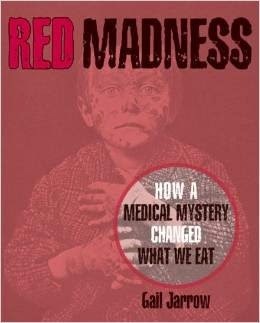 Written with clear language accessible to readers from age ten through adult, Gail Jarrow chronicles the history, myths, and treatments associated with pellagra. Dr. Goldberger's tireless efforts to determine the primary cause of pellagra included hosting "filth parties." In gruesome detail, Gail describes how Goldberger tried infecting himself with pellagra in order to prove that it was not contagious or a result of infection.
Written with clear language accessible to readers from age ten through adult, Gail Jarrow chronicles the history, myths, and treatments associated with pellagra. Dr. Goldberger's tireless efforts to determine the primary cause of pellagra included hosting "filth parties." In gruesome detail, Gail describes how Goldberger tried infecting himself with pellagra in order to prove that it was not contagious or a result of infection.
 http://www.loc.gov/pictures/item/ncl2004004556/PP/
http://www.loc.gov/pictures/item/ncl2004004556/PP/
"This Oklahoma sharecropper and his family pick cotton in 1916.
The older two children--ages six and five--together picked twenty-five pounds of cotton a day.
Goldberger tried to communicate his message about diet to farmers and mill workers,
two groups that suffered from pellagra." (p.100)Since the disease appeared most often in poor households where diets were limited to 3-M's: meal (cornmeal baked into bread), meat (fatback, form the fatty layer on a pigs back) and molasses (syrup), Goldberger was convinced that pellagra was probably caused by a diet deficiency. But how could he prove that? Goldberger spent eleven years, traveling frequently in the South where the disease was most common, and performed experiment after experiment.
In 1923 his efforts finally paid off. Experimenting with dogs who were experiencing pellagra symptoms, Goldberger fed them brewer's yeast (something missing from most pellagrins' diets). Quickly, the dogs recovered. In 1926 the Mississippi River flooded. 700,000 people lost their homes and 45-50,000 developed pellagra. The Red Cross took Goldberger's recommendation to add yeast to the impoverished people's diet. Within two months people were cured.
After Goldberger died in 1928, other scientists continued searching for the vitamin that would prevent pellagra. Eventually, Conrad Elvehjem discovered that nicotinic acid (now known as niacin) was indeed, the pellagra-preventing vitamin. Ten years later bakers began adding niacin, along with other Vitamin B complex vitamins to bread. That was the beginning of the enriched bread we enjoy today.
According to a recent Writer's Digest article, "Straight Up Nonfiction with a Twist," one way authors enhance text is by using sidebars for supplemental material. Gail and her team at Calkins Creek did an excellent job of interweaving newspaper headlines, facts, and photos such as this one into the body of the text.
 "Some doctors referred to the butterfly-shaped rash on the
"Some doctors referred to the butterfly-shaped rash on the
girls neck as the Collar of Casal, named after
the first doctor to write about pellagra." (p. 83)In addition, dozens of case histories of individuals whose lives were torn apart by the disease, are sprinkled throughout the book.
In a recent SCBWI, Bulletin article, "What Teachers Want from Nonfiction Authors," Alexis O'Neill said that teachers wanted authors to share about their research and writing process. Accordingly, I asked Gail a few questions about her process.
Carol: What was it like for you to see the images of people afflicted with pellagra and pulling them together for this book?
Gail: Part of me approached this topic in a clinical manner. I have a background in biology, and I was fascinated to learn how a vitamin deficiency could lead to such dramatic physical symptoms. But when I read the accounts of patients’ suffering written by their doctors, I felt upset knowing this disease was so easy to prevent. Even after pellagra’s cause and cure were discovered—and publicized—people continued to fall ill and die. Many victims lacked the resources to eat properly or didn’t realize how diet affected their bodies. Tragically, other deaths occurred because some physicians refused to accept that pellagra was a diet deficiency disease.
Carol: Was any part of this writing/publishing journey more difficult than another?
Gail: The hardest part—and this is always the case when I write a non-fiction book—is locating and obtaining the primary documents. Those were key because secondary sources were contradictory about the early-20th-century understanding of pellagra, Joseph Goldberger and his research, and other details included in my book. Whenever possible, I go back to the original sources and do not necessarily trust what I read elsewhere. Too many times, I’ve found errors in the secondary sources.
For more information on the nitty gritty behind writing this book, see the informative Author's Note at the end of the book and Gail's interview in the School Library Journal. Teachers, make sure you utilize the educational activities which Gail has assembled. With such a detailed analysis of the disease, what caused it, and the stigmas associated with the disease, Red Madness will be an excellent supplement to history, sociology, and science lesson plans.
*******I usually give away the books which I receive to review. This time I donated Red Madness to The Christian Academy, where my daughter teaches. In an upcoming blog I plan to review another new book by Gail, Fatal Fever: Tracking Down Typhoid Mary. You'll have a chance to win that one; both books are outstanding additions to any home or school library.
Read this book and maybe you'll discover answers to the mystery disease which left its mark on someone you know.
*******How many of you have heard of pellagra? Before reading Red Madness , I was unfamiliar with the disease. But reading it resolved a personal mystery for my husband's 85-year-old uncle. He finished the book and said, "Now I know what I had as a child."
This disease which produces a horrible skin rash, leads to severe intestinal problems, causes neurological problems, and often leads to death, no longer afflicts wide portions of our population--the way it did during the first half of the twentieth century. Pellagra has been eradicated from most developed countries because of the tireless work of one physician: Joseph Goldberger. Red Madness by award winning author Gail Jarrow, describes how this medical mystery was solved.
 Written with clear language accessible to readers from age ten through adult, Gail Jarrow chronicles the history, myths, and treatments associated with pellagra. Dr. Goldberger's tireless efforts to determine the primary cause of pellagra included hosting "filth parties." In gruesome detail, Gail describes how Goldberger tried infecting himself with pellagra in order to prove that it was not contagious or a result of infection.
Written with clear language accessible to readers from age ten through adult, Gail Jarrow chronicles the history, myths, and treatments associated with pellagra. Dr. Goldberger's tireless efforts to determine the primary cause of pellagra included hosting "filth parties." In gruesome detail, Gail describes how Goldberger tried infecting himself with pellagra in order to prove that it was not contagious or a result of infection.  http://www.loc.gov/pictures/item/ncl2004004556/PP/
http://www.loc.gov/pictures/item/ncl2004004556/PP/"This Oklahoma sharecropper and his family pick cotton in 1916.
The older two children--ages six and five--together picked twenty-five pounds of cotton a day.
Goldberger tried to communicate his message about diet to farmers and mill workers,
two groups that suffered from pellagra." (p.100)Since the disease appeared most often in poor households where diets were limited to 3-M's: meal (cornmeal baked into bread), meat (fatback, form the fatty layer on a pigs back) and molasses (syrup), Goldberger was convinced that pellagra was probably caused by a diet deficiency. But how could he prove that? Goldberger spent eleven years, traveling frequently in the South where the disease was most common, and performed experiment after experiment.
In 1923 his efforts finally paid off. Experimenting with dogs who were experiencing pellagra symptoms, Goldberger fed them brewer's yeast (something missing from most pellagrins' diets). Quickly, the dogs recovered. In 1926 the Mississippi River flooded. 700,000 people lost their homes and 45-50,000 developed pellagra. The Red Cross took Goldberger's recommendation to add yeast to the impoverished people's diet. Within two months people were cured.
After Goldberger died in 1928, other scientists continued searching for the vitamin that would prevent pellagra. Eventually, Conrad Elvehjem discovered that nicotinic acid (now known as niacin) was indeed, the pellagra-preventing vitamin. Ten years later bakers began adding niacin, along with other Vitamin B complex vitamins to bread. That was the beginning of the enriched bread we enjoy today.
According to a recent Writer's Digest article, "Straight Up Nonfiction with a Twist," one way authors enhance text is by using sidebars for supplemental material. Gail and her team at Calkins Creek did an excellent job of interweaving newspaper headlines, facts, and photos such as this one into the body of the text.
 "Some doctors referred to the butterfly-shaped rash on the
"Some doctors referred to the butterfly-shaped rash on thegirls neck as the Collar of Casal, named after
the first doctor to write about pellagra." (p. 83)In addition, dozens of case histories of individuals whose lives were torn apart by the disease, are sprinkled throughout the book.
In a recent SCBWI, Bulletin article, "What Teachers Want from Nonfiction Authors," Alexis O'Neill said that teachers wanted authors to share about their research and writing process. Accordingly, I asked Gail a few questions about her process.
Carol: What was it like for you to see the images of people afflicted with pellagra and pulling them together for this book?
Gail: Part of me approached this topic in a clinical manner. I have a background in biology, and I was fascinated to learn how a vitamin deficiency could lead to such dramatic physical symptoms. But when I read the accounts of patients’ suffering written by their doctors, I felt upset knowing this disease was so easy to prevent. Even after pellagra’s cause and cure were discovered—and publicized—people continued to fall ill and die. Many victims lacked the resources to eat properly or didn’t realize how diet affected their bodies. Tragically, other deaths occurred because some physicians refused to accept that pellagra was a diet deficiency disease.
Carol: Was any part of this writing/publishing journey more difficult than another?
Gail: The hardest part—and this is always the case when I write a non-fiction book—is locating and obtaining the primary documents. Those were key because secondary sources were contradictory about the early-20th-century understanding of pellagra, Joseph Goldberger and his research, and other details included in my book. Whenever possible, I go back to the original sources and do not necessarily trust what I read elsewhere. Too many times, I’ve found errors in the secondary sources.
For more information on the nitty gritty behind writing this book, see the informative Author's Note at the end of the book and Gail's interview in the School Library Journal. Teachers, make sure you utilize the educational activities which Gail has assembled. With such a detailed analysis of the disease, what caused it, and the stigmas associated with the disease, Red Madness will be an excellent supplement to history, sociology, and science lesson plans.
*******I usually give away the books which I receive to review. This time I donated Red Madness to The Christian Academy, where my daughter teaches. In an upcoming blog I plan to review another new book by Gail, Fatal Fever: Tracking Down Typhoid Mary. You'll have a chance to win that one; both books are outstanding additions to any home or school library.
Read this book and maybe you'll discover answers to the mystery disease which left its mark on someone you know.

Published on April 13, 2015 03:00



